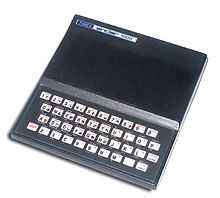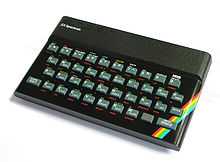Timex Sinclair 1000
 | |
| Type | Home computer |
|---|---|
| Release date | July 1982 |
| Discontinued | 1983 |
| Operating system | Sinclair BASIC |
| CPU | Zilog Z80A @ 3.25 MHz |
| Memory | 2 KB |
The Timex Sinclair 1000 (TS1000) was the first computer produced by Timex Sinclair, a joint-venture between Timex Corporation and Sinclair Research. It was launched in July 1982.
The TS1000 was a slightly-modified Sinclair ZX81 with an NTSC RF modulator instead of a UK PAL (Units sold in Portugal have a PAL RF modulator) device and the onboard RAM doubled to 2K. The TS1000's casing had slightly more internal shielding but remained the same as Sinclair's, including the membrane keyboard. It had black-and-white graphics and no sound. It was followed by an improved version, the Timex Sinclair 1500.
Like the Sinclair ZX81, the TS1000 used a form of BASIC as its primary interface and programming language. To make the membrane keyboard less cumbersome for program entry, the TS1000 used a shortcut system of one-letter "keywords" for most commands (e.g. pressing "P" while the cursor was in "keyword mode" would generate the keyword "PRINT"). Some keywords required a short sequence of keystrokes (e.g. SHIFT-ENTER S would generate the keyword "LPRINT"). The TS1000 clued the user in on what to expect by changing the cursor to reflect the current input mode.
The TS1000 sold for $99.95 in the US when it debuted, making it the cheapest home computer to date at the time of its launch (its advertising angle was "the first computer under $100".) This pricing initiated a price war with Commodore International, who quickly reduced the price of its VIC-20 to match and later announced a trade-in program offering $100 for any competing computer toward the purchase of a Commodore 64. Since the TS1000 was selling for $49 by this time, many customers bought them for the sole purpose of trading it in to Commodore.
The black-and-white display showed 32 columns and 24 lines, 22 of which were normally accessible for display, with 2 reserved for data entry and error messages. The limited graphics were based on geometric shapes contained within the operating system's non-ASCII character set. The only form of long-term storage was a home tape cassette recorder. The 16K memory expansion sold for $49.95. A shortage of the memory expansions coupled with a lack of software that would run within 2K meant that the system had little use for anything other than an introduction to programming. Home computer magazines of the era such as Compute! showed enthusiasts how to interface the computer with various kinds of equipment, providing the opportunity for learning about early speech synthesis technology through a Speak & Spell, robotics control through the memory port, and scrolling text displays for advertising.
Over time, the TS1000 spawned a cottage industry of third-party add-ons designed to help remedy its limitations. Full-size keyboards, speech synthesizers, sound generators, disk drives, and memory expansions (up to 64K) were a few of the options available. Languages such as Forth and Pascal, as well as BASIC compilers and assemblers augmented the TS1000's programming possibilities. Microcomputing magazine published an article in April 1983 decrying the membrane keyboard ("The designers of the Timex-Sinclair 1000 ... reduced this important programming tool to a fraction of the required size") and describing how to wire up external full-size keyboards.
Timex Sinclair 1500

The TS1500 was a slightly-upgraded development of the TS1000. Timex Sinclair (TMX Portugal) designed the TS1500 and offered it to the Timex Corporation; they used the TS2000 (ZXSpectrum) silver cases that were never used because of the launch of the TS2068. The TS1500 replaced the earlier machine's ZX81-like case with a silver ZX Spectrum-like case, the same ZX Spectrum rubber keyboard, a custom ULA, and increased the onboard RAM to 16K. The TS1500 did not incorporate the Ferranti ULA.
The TS1500 used a standard television for its display, "broadcasting" on either channel 2 or 3. It defaulted to TV channel 2, but if the "3" was pressed on the keyboard within a few seconds of turning the computer on, it changed to channel 3 instead.
Although the TS1500 came with 16K internal RAM, an external 16K RAM pack could be added for a total of 32K RAM. A few keyboard commands (POKEs) were required for the system to recognize the additional memory space (the RAM pack is multiplexed to the start of the RAM).
In spite of this, it was not a commercial success because it was launched too late. The ZX 81/TS1000's successors, the ZX Spectrum/TS2068, were already available, and the home computer market in general was dominated by Commodore, Atari and Apple. It was sold in the USA and Portugal.
Bugs
There are two little-known software differences between the TS1000 and TS1500.
On the TS1000 and ZX81, the command:
LPRINT 0.00001
results in the Timex printer outputting 0.0XYZ1. This well-known fault was corrected on the TS1500.
The TS1000 runs the following loop correctly, but the TS1500 does not; it makes one fewer iteration than it should.
10 FOR I = 0 TO 1 STEP .25 20 PRINT I 30 NEXT I
Peripherals
As explained in the "User's Guide" for the TS1000, when connected to a B/W TV a clock could be produced without a cartridge. Timex Computer Corporation produced a cartridge interface for the TS1000, the Timex Sinclair 1510 Command Cartridge Player. Only four cartridge titles were ever released:
- 07-9001 Supermath
- 07-9002 States and Capitals
- 07-9003 Chess
- 07-9004 Flight Simulator
The TS1510 can be used with a TS1000 and a 16K RAM Pack.
External links
- 1982: Timex Sinclair Computer
- Timex Sinclair 1000
- Timex Sinclair / ZX81 Museum
- Suitcase version of Timex Sinclair 1500
- Timex Computer World-Timex Sinclair 1500
- Timex Computer World-Timex Sinclair 1510
- Timex Computer World - Pictures of Timex Sinclair 1500
- Timex Computer World - Pictures of Timex Sinclair 1510
- Timex Sinclair 1000 Fan Page
- Historycorner.de - German Site for the Timex Sinclair 1000
| ||||||||||||||||||||||||||||
